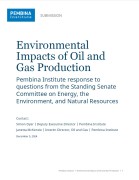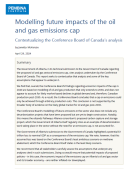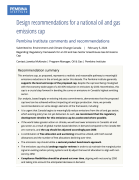In September 2022, the Pembina Institute submitted comments to Environment and Climate Change Canada on its two proposed options for capping oil and gas sector emissions.
This cap will be crucial in ensuring that Canada’s oil and gas sector contributes its fair share of greenhouse gas emissions reductions to Canada’s economy-wide targets (of a 45% reduction below 2005 levels by 2030, and net-zero by 2050). Oil and gas production remains Canada’s largest source of emissions, and unlike some other industrial sectors, its emissions have continued to grow in recent years — by 19% between 2005 and 2019. To do its fair share, Canada’s oil and gas sector must also reduce its emissions by 45% from 2005 levels by 2030.
Recommendation Summary
Prior to investing more time in detailed regulatory design, Environment and Climate Change Canada should finalize and announce a clear emissions cap target for 2026 and 2030. This announcement should be made before COP27 (due to be held in November 2022). At a minimum, the cap for oil and gas sector emissions should be set at a 45% reduction from 2005 levels by 2030, with clear implementation timelines. Providing this level of certainty on the trajectory and ambition of the cap is critical to incentivize urgent investments in decarbonization. Recent opinion polling illustrates that most Canadians agree that it is time for a cap on emissions from oil and gas production, to ensure that this sector does its fair share in achieving Canada’s climate targets.
Both cap Options 1 and 2 are complex, and require careful design and implementation to ensure appropriate emissions reductions, while preparing Canadian industry for a net-zero global economy. Both Options could be workable from the perspective of the following principles considered in this feedback:
Be certain: Provide policy certainty early through all possible mechanisms, such as setting interim targets, improving the stringency of the OBPS, creating new policies regarding carbon contracts for difference and carbon border adjustment mechanisms.
Be ambitious: Aim for a reduction in oil and gas emissions of 45% below 2005 levels by 2030, and institute a cap trajectory that incentivizes early action towards that goal. The 2030 cap level should be announced now, before further regulatory design takes place, similar to how the Government of Alberta clearly signaled an oilsands emissions cap limit of 100 Mt in the Oilsands Emissions Limit Act (2016) prior to determining the exact mechanism to achieve it.
Be timely: Be implemented as early as possible, targeting 2024 coming into force.
Be efficient: Minimize additional administrative burdens and unintended impacts and be implemented in the most cost-effective manner to achieve the cap trajectory.
Be flexible: Provide flexibility within the oil and gas sector, while excluding intra-sector trading.
Limit additional government support: No additional decarbonization subsidies should be considered after the upcoming CCUS Investment Tax Credit and credits from the OBPS (or provincial equivalents) and Clean Fuel Regulations.
Allocate revenue to climate priorities: Revenues generated should be allocated to workers and communities affected by the energy transition, addressing orphan and abandoned well liabilities, driving significant emissions reductions, and emissions measurement improvements.
Considering these principles, together with the urgency of reducing Canada’s rising oil and gas sector emissions, Option 1 (cap-and-trade) is preferred. It likely offers the earliest implementation date (in 2024 or early 2025) and could be designed to work with existing measures to further incentivize the oil and gas sector to do its fair share to meet Canada’s 2030 emission reduction targets.
If the Government of Canada does not believe Option 1 can implemented in these stated timelines, we propose a third option — a system of facility-level emissions limits similar to the federal coal-fired electricity facility limits. This interim option should be rapidly implemented to drive timely emission reductions at oil and gas facilities. Option 1 could still be developed in parallel and implemented when ready. At that time, the facility limits could be rescinded, if found to be redundant with cap-and-trade.










